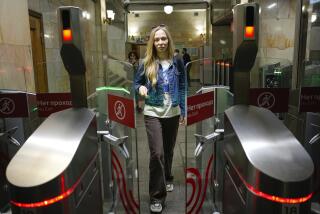Soviets Free the Dreaded Photocopier
MOSCOW â Forty years into the era of xerography, the Soviet Union is getting ready to move its photocopiers from their guarded, double-locked, steel-covered doors as the country tries to catch up with the worldwide explosion of information.
The Soviet Ministry of Interior Affairs announced Wednesday that it wants to ârelinquish control over the acquisition, storage and operation of copying equipment,â admitting that photocopiers are now standard office equipment and not really the grave threat to state security they were once perceived to be.
The ministryâs Second Department of the Main Directorate of Protecting Public Order acknowledged that the recent spread to more than 60,000 different Soviet organizations of kseroks machines, as all photocopiers are called in Russian, had made its task of supervising their operation virtually impossible.
In what will be a major step toward implementing President Mikhail S. Gorbachevâs policy of free-flowing information under glasnost, or political openness, the ministry is drafting regulations permitting government offices, scientific institutions, enterprises and other organizations to assume responsibility for their own photocopiers.
The immediate impact will probably be the importation of thousands more copiers--as soon as the foreign exchange can be found to buy them.
Inspectors from the Interior Ministry will no longer be checking each machine to ensure that it is locked in secure quarters, that complete registers are kept of the documents copied and that the numbers of copies correspond to the tamper-proof counters required on each machine.
The truly conscientious inspectors had also checked the desks of the operators for unauthorized materials and seized such contraband as horoscopes and sex manuals.
âSemi-Criminal Operationâ
Acknowledging that hundreds of thousands of Soviet citizens--engineers, students, scientists, even grandmothers with medical records--need documents copied every day, the government newspaper Izvestia observed Wednesday that those people have faced either very long lines, as they and their papers were scrutinized at authorized photocopier offices, or âa semi-criminal operationâ to get papers copied quickly in violation of government controls.
Under the elaborate âinstructions on procedures of printing nonclassified documentation,â adopted in 1974 to prevent dissidents from photocopying their political tracts, then known as samizdat, or âself-publishedâ materials, getting anything copied was never quick and never anonymous.
The official reasons for all these controls--to prevent the copying of confidential documents in a state obsessed with secrecy and to thwart counterfeiters--were valid, Izvestia said, noting as well that âthe primary goal was to prevent the proliferation of undesirable textsâ in the Soviet Union.
âFrom the first days of Soviet power,â the paper added, âeven typewriters were put under tight supervision, and that incidentally was abolished only recently.â
V. Vashenko, the chief of the Second Department of the Main Directorate of Protecting Public Order, told Izvestia that, in fact, new technology has overtaken the controls on photocopiers.
With computers, optical scanners, laser printers and other equipment for desk-top publishing able âto produce a whole newspaperâ and not subject to the same strict controls as photocopiers, the regulations governing copiers have become pointless.
âIt is simply impossible to control this process now,â Vashenko told Izvestia.
Once so rare that access was limited to top government and Communist Party officials, scientists at the most prestigious research institutes and the KGB, the state security agency, photocopiers have proliferated to the extent that political activists of almost every kind have easy access to them.
More to Read
Sign up for Essential California
The most important California stories and recommendations in your inbox every morning.
You may occasionally receive promotional content from the Los Angeles Times.








